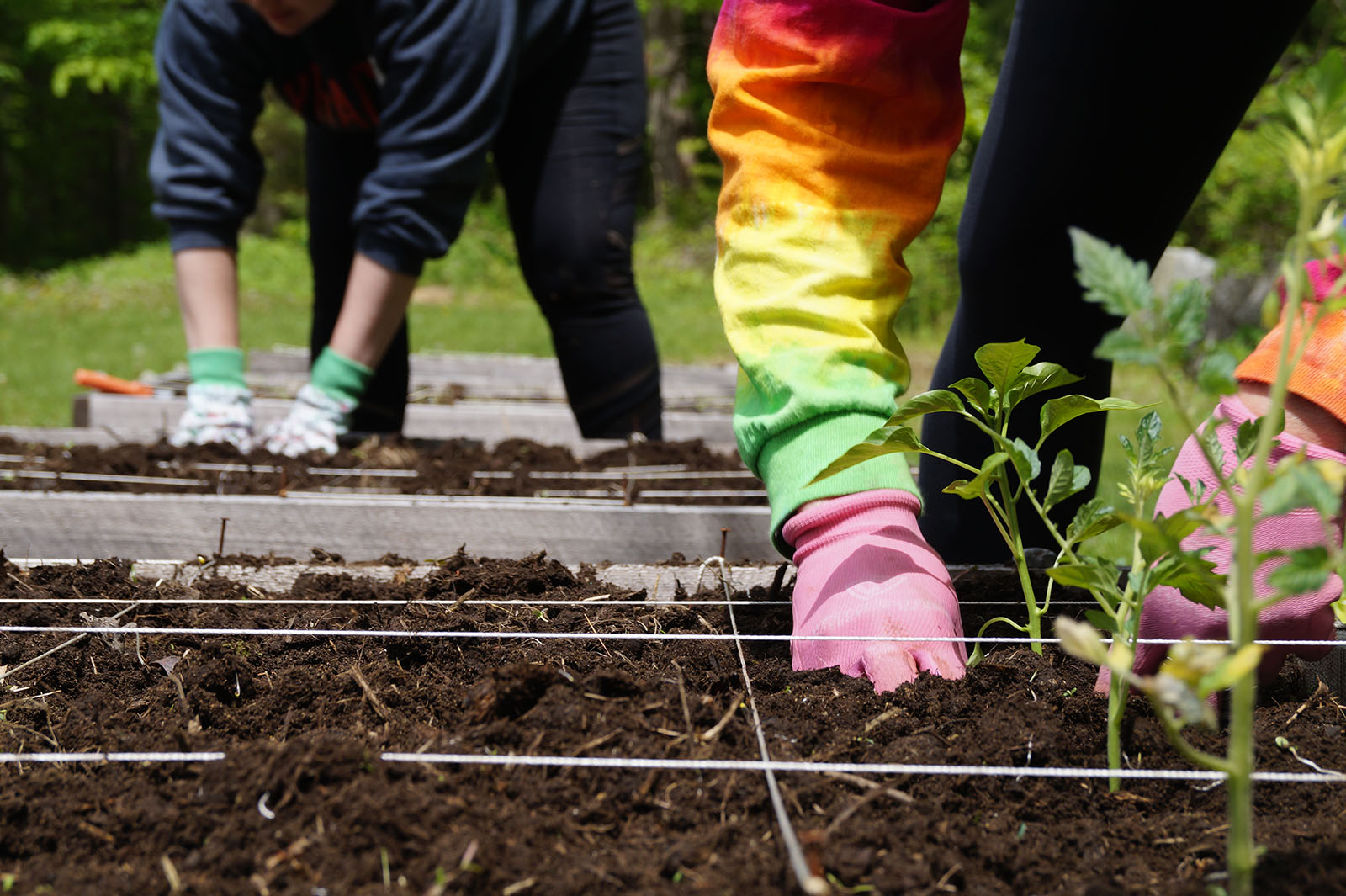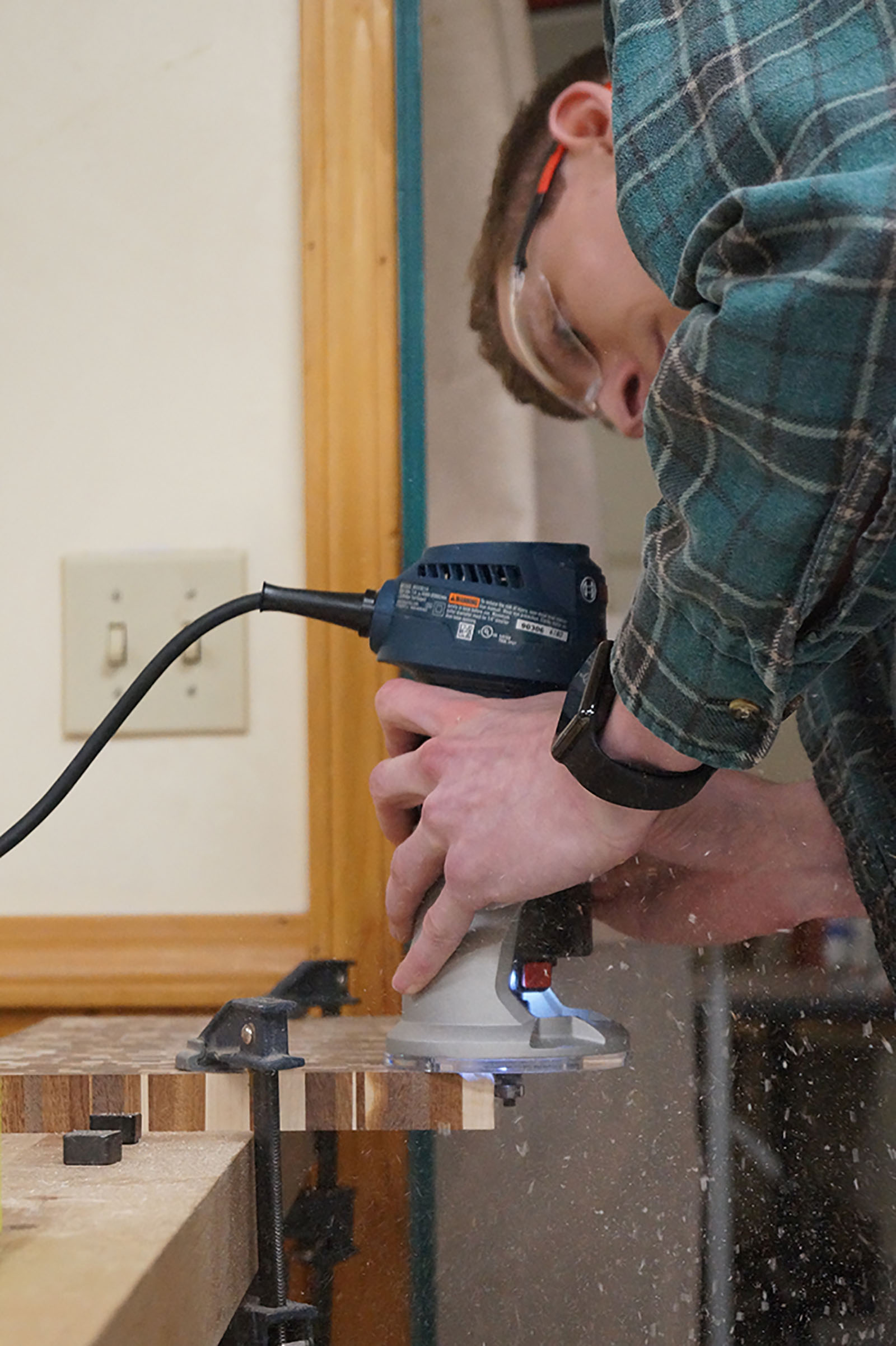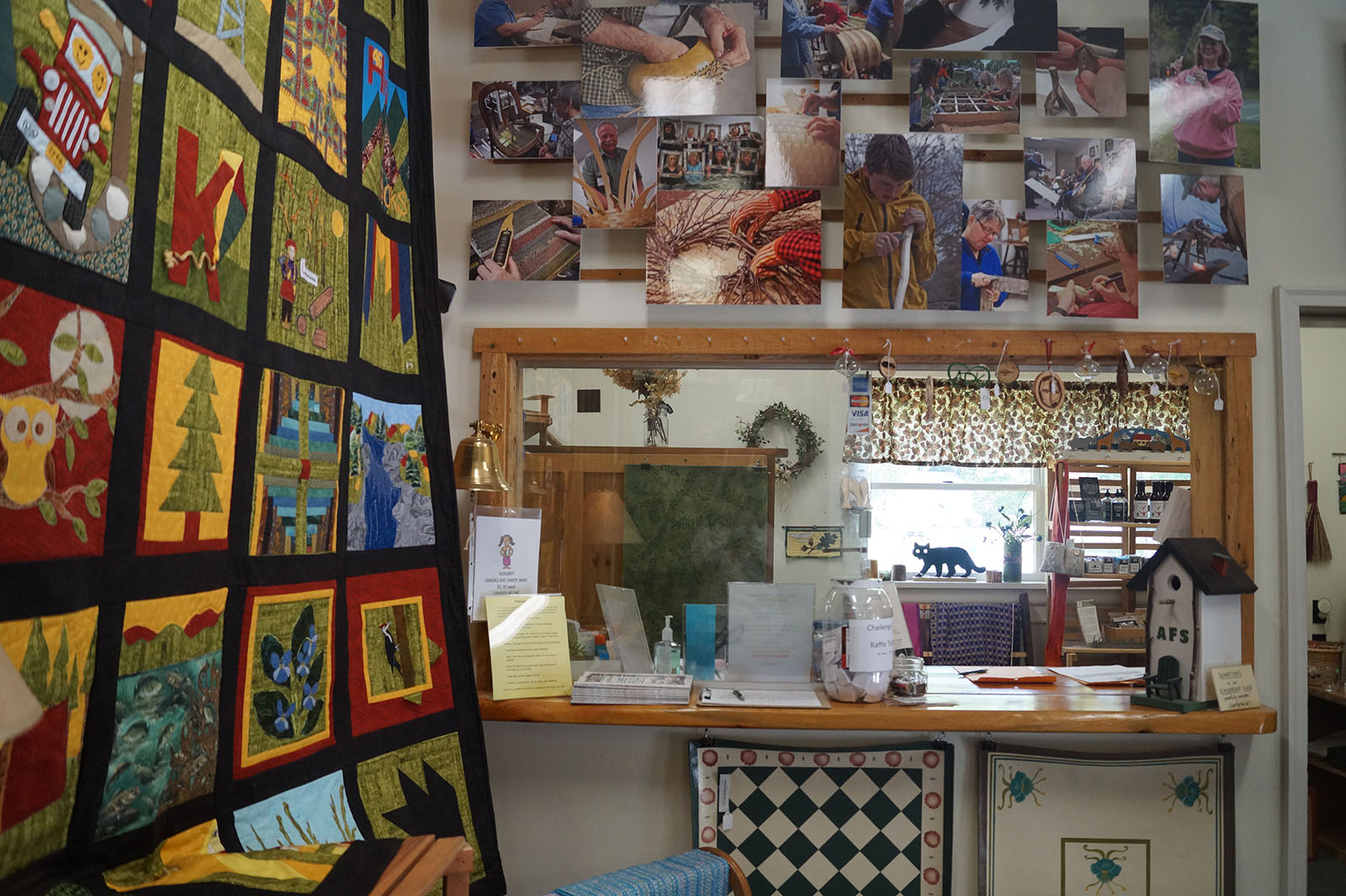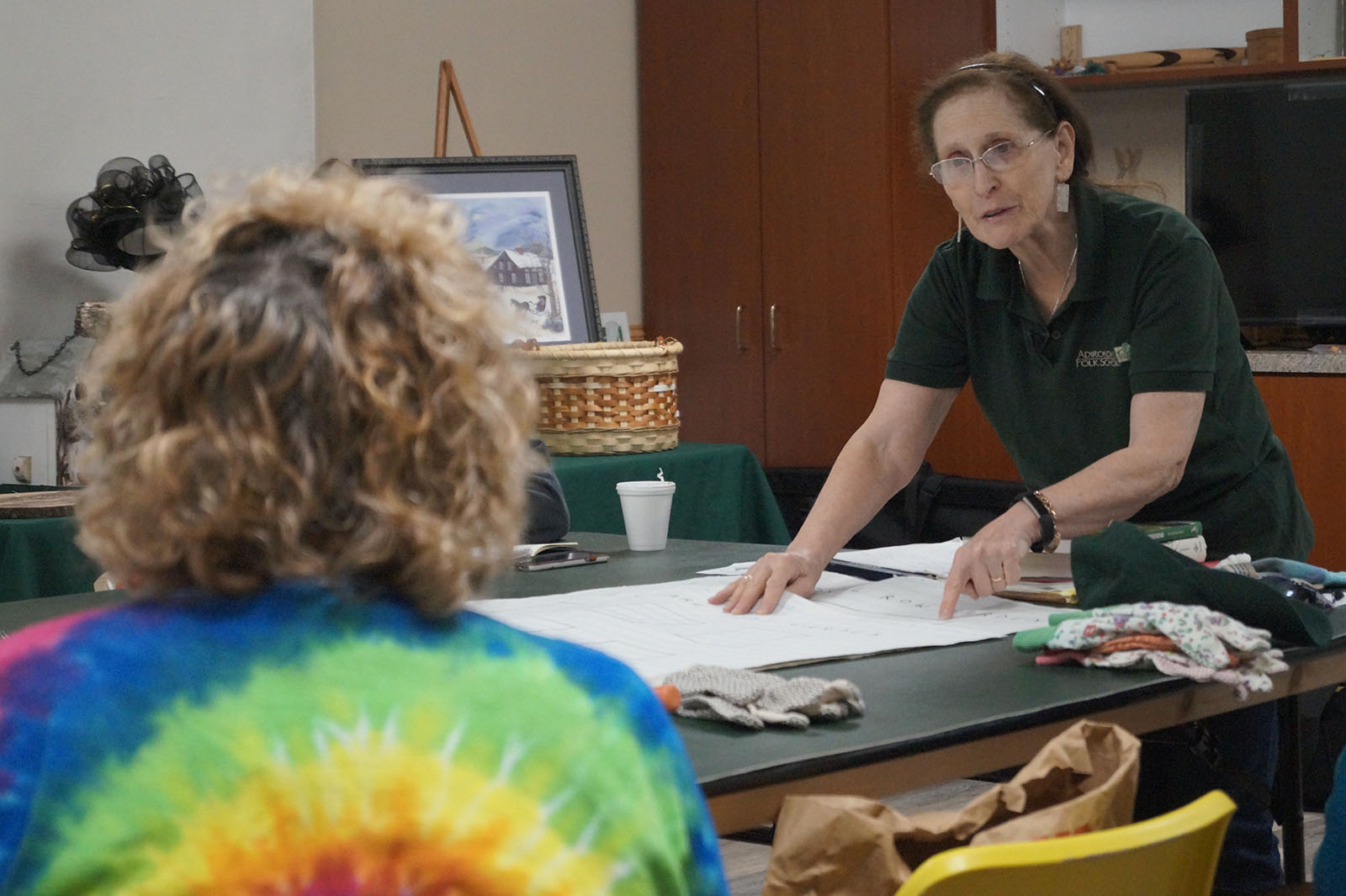Elizabeth White is a vertical editor and contributing writer for…
Rachel Burt is the copy chief and contributing writer for…
A wooden canoe sits in one corner of the classroom in the Adirondack Folk School in Lake Luzerne, a small upstate N.Y. town that sits at the southern foothills of the Adirondack mountains next to the narrow northern stream of the Hudson River. On a Saturday morning, Patricia Goldberg, 75, a thin woman with gray hair pulled back into a ponytail and a pair of glasses perched on the top of her head, greets students enrolled in her “square-foot gardening” class as they walk inside. Goldberg, an instructor at the folk school since its founding in 2010, announces to her class that they can also take an 11-day, canoe-building class and leave with their own usable canoe, just like the one in their classroom. In fact, the school offers more than 250 courses a year taught by 70 skilled artisans. Evidence of their work decorates the former town hall which the school is housed in. A hand-stitched alphabet quilt hangs in a small room next to the reception window while handmade soap, jewelry, and wooden items are displayed for sale in a small front room. Various hand-woven baskets and small crafts take up another table. Sliding glass doors in the back of the room lead to the school’s backyard where the garden and blacksmithing shed are.
Before heading outside, Goldberg explains the basics of square-foot gardening, a more efficient and less wasteful technique that uses 20% of the space of a regular garden, with a lecture and demonstration. Then, Goldberg leads her students, seeds and small plants in hand, down a slope of grass to four wooden gardening boxes, each nicely sectioned off into 16 square feet. Each square holds a different plant, Goldberg explains. Her students pull on their gardening gloves, arrange kneepads on the grass, and get to work tilling the soil in each box, preparing to plant for the spring season. They begin with the starter plants, which are plants that have already sprouted and are quicker to produce vegetables than seeds. A blonde woman in her 50s — an eighth-grade math teacher from Pine Bush, N.Y. who is about to retire and start a new garden at home — digs a hole with a trowel for a baby cabbage plant.

Folk schools like this offer all people, from young parents with kids to retirees, the chance to learn the traditional skills, arts, crafts, and culture of a particular region. Students learn new things such as herbalism, soap making, beekeeping, gardening, and even blacksmithing. And despite their focus on the abilities of an earlier era, they attract a growing number of digital-age students and are increasing in number across the United States with 82 active folk schools as of July 2018, and 42% of them are less than three years old, says Dawn Murphy, secretary of the Folk Education Association of America and a doctoral student studying the folk school movement. Beyond schools, there are organizations that seek to build community among them. The Folk Education Association of America (FEAA), for example, is a small volunteer organization that was originally founded in 1976 by Kay Parke and John Ramsay who studied the history and philosophy of folk schools in Denmark and wanted to formally organize folk schools in the United States. FEAA went into hiatus in 2001 after issues arose with the board of directors, but a new organization called the Folk School Alliance was created within it in 2014, Murphy says. Their main focus was to connect new and old folk schools, provide workshops on how to start a folk school, and educate people on America’s folk school movement.
Murphy says that based on her research, folk schools have increased nearly sevenfold since 1990. Although there aren’t any formal studies on folk schools yet, Murphy and folk school instructors theorize that the changing culture and increasing dependence on technology inspire people to seek out ways to step away from the screen and do things in nature with their hands. Kerri Hamos, program director at The Folk School in Fairbanks, Alaska, also credits technology with driving the resurgence of folk schools. “Even though it’s not a constant thought process, I think that people are coming to the realization that we need to be making things and doing things with our hands, and that there’s a real joy that can be found in doing those things in a community of like-minded people,” Hamos says. “It feels really good to come to the folk school, whether it’s for a few hours or a whole weekend, and sit among your peers and learn something new and walk out with something you made.”
Pattie Bagley, a resident artist at the John C. Campbell Folk School in North Carolina, echoes that sentiment, adding that people are appreciating the simple things in life again. “I think mostly, in everyone’s daily life, generally, people don’t make a lot of things,” Bagley says. “People are so disconnected from how things are made and how the world generally works. Right now, there’s a great appreciation for handmade items.”

Others reference politics. “I think the political climate has played well in our favor; people are just looking for a rest from the noise and the rancor, regardless of political affiliation,” says Scott Hayden, executive director of the Adirondack Folk School, adding he has seen a 70% increase in enrollment since 2016. “I think people are seeking a quieter place of learning where you can just simply learn how to do a craft with an expert artisan.” He also points out that folk schools allow people to experiment with crafts among other craft-curious people without investing in tools. “If you don’t have a woodshop and you want to try making a cabinet, how are you going to do that? The equipment is expensive,” he says. “What if I don’t like it? There are horrible barriers for people trying new things. That’s where our folk school comes in.”
Even though it’s not a constant thought process, I think that people are coming to the realization that we need to be making things and doing things with our hands, and that there’s a real joy that can be found in doing those things in a community of like-minded people.
The idea of a folk school began with philosopher and theologian Nikolai Frederik Severin Grundtvig in Denmark in the 1830s, a time of political unrest in the country. The Danish sought to re-establish themselves as the country moved from a monarchy to a democracy, and Grundtvig felt that folk schools would help the Danish embrace democracy and participate in the community. “A lot of what Grundtvig talked about in terms of folk education was civic engagement, democracy, and setting up experiences for rural folks to engage in their own history, their own language, and their own identity, and to gain power from that,” Murphy says. Grundtvig tried to start a school but failed because he couldn’t manage it. It wasn’t until 1851 that Kristen Kold, a follower of Grundtvig’s work, founded the first successful folk school in Denmark.

Folk schools made their way to American soil in waves. The first folk schools in North America were Danish-American folk schools, which were founded by Danish immigrants who wanted to replicate the Danish folk school model and keep Danish culture and tradition alive in America. The first Danish-American Folk School opened in 1878 in Elk Horn, Iowa. “One of the really firm philosophies, and partly why the Danish American folk schools disappeared, is that you can’t transplant a folk school,” Murphy says. “You can’t take a model from Denmark and plant it in the soil in North America and expect it to be the same sort of school that it was in Denmark.”
After visiting Denmark, another batch of Americans began the next wave of folk schools in the 1920s and 1930s. Some are still around today, including the John C. Campbell Folk School, which was established in 1925, and The Highlander Research and Education Center (formerly the Highlander Folk School), which was founded in 1932. Murphy believes that these second-wave folk schools succeeded because the needs of the community informed their creation. “You stick your finger in the soil and smell the needs of the people and the needs of the place,” Murphy says. “That’s where you have the folk school — where the needs of the people and the talent of the teacher come together.”
I think the political climate has played well in our favor. People are just looking for a rest from the noise and the rancor, regardless of political affiliation.
Murphy believes that the current wave of folk schools can be attributed to economic hardships, like the decline of manufacturing and struggling farmers, which forces cultural change. “What’s your response when the way that you understand the world, how to function in the world, and what makes a good person in your community, what happens when that dramatically changes?” Murphy says.
Today, folk schools around the country offer an educational experience to people looking to make things with their hands and learn new skills. And despite their focus on techniques and skills forged by previous generations, they deliver and address some modern-day issues and deficiencies. “A lot of people think of folk education as a sort of static preservation of an old skill, but it’s more folk life in that it’s very temporal. It’s meeting the needs of the people in the place where the school is,” Murphy says. The Folk School Alliance conducted a 2017 survey with around 35 folk school participants to see what folk schools across America focus on. The top answers include lifelong learning, traditional skills (both tied at 82.4% of responses), and arts and crafts (76.5%). Hamos says that their most popular classes are hand-carved woodworking and fiber arts classes. “Every folk school has a regional flavor to it, for sure,” Hamos says. “I think that the classes are really birthed from the community.”
At the Adirondack Folk School, the most popular classes are in blacksmithing, basket weaving, and woodworking. Hayden attributes the huge popularity of blacksmithing to dedicated and talented instructors and to the fact that it is one of the only places to take blacksmithing classes in the Northeast region. Goldberg also points out that the school specializes in Adirondack crafts. The best example is a class on how to make a mountaineer Adirondack pack basket. The class extends over two days and instructs students on the weaving of the iconic, large basket with straps that can be used for hiking, Goldberg explains. Randy Flavin, 54, who lives in Durham, N.Y. and works in the tree-care industry, took that class and made a Sightseer Pack Basket, also called a hiker pack. He praises the patience of his instructor, Linda Scherz, who has been weaving baskets since the late 1980s and now teaches basket-weaving classes throughout the eastern United States.

Meanwhile, soap drew Tammy Prosser, 47, a clothing store employee who lives in Bolton Landing, N.Y., to the Adirondack Folk School. She took a cold-press, soap-making class and describes the instructor, Roberta Devers-Scott, as “knowledgeable, extremely kind, and helpful.” She says they learned about eye and lung protection and how to mix and measure the soap ingredients. Devers-Scott also shared a helpful website for suggestions about adding oils into the soap and provided access to a Facebook group for soap-making questions and inspiration. She loved the class so much that she hopes to open a soap-making business on the side in the future.
Folk schools draw in a range of people, but in particular, they attract homesteaders, Hayden says. But Hayden says it’s hard to know how many students count themselves as part of that community. Bagley says she has seen several homesteaders come through the John C. Campbell Folk School, noting they usually pursue classes in beekeeping, smoking meats, and woodworking.
Back at the Adirondack Folk School, students finish their burgers at a cafe up the street that sits alongside the Hudson River and then head back to learn more about square-foot gardening. That afternoon, the students crouch down once again and begin working on their small plots. “The smaller the seed, the closer to the surface of the dirt it should be,” Goldberg says as she stands next to a student. The student pokes nine small holes in the dirt with her thumb and carefully places nine bean seeds inside. The class finishes planting seeds in the boxes before heading inside to learn about plant protection and extending the seasons in the garden. “We live in a world of perfect, and it has no meaning. Something that is machine-made is a perfect replica of its cast or its mold or how it was designed to be built. It has no character. It just functions as it should,” Hayden says. “So when we make something by hand, a piece of us becomes a part of that that can’t be replicated. You can’t buy that sense of accomplishment. You have to do it yourself to get that.”
Correction 11/20/19: The Adirondack Folk School is one of the only places in the Northeast to take blacksmithing classes, not the Pacific Northeast.
Elizabeth White is a vertical editor and contributing writer for Rooted. She received her master’s degree in the Magazine, Newspaper and Online Journalism program at the S.I. Newhouse School of Public Communications at Syracuse University. She likes writing about everything from arts and culture to community topics and politics. Liz also enjoys going to the beach, snuggling with her cat Rosemary, and traveling.
Rachel Burt is the copy chief and contributing writer for Rooted. She received her master’s degree in the Magazine, Newspaper and Online Journalism program from the S.I. Newhouse School of Public Communications at Syracuse University. She recently joined the Watertown Daily Times as a general assignment reporter. In her limited spare time, she likes to read, sing, and watch Netflix, as well as spend time with her pets: Elana, Oliver, and Luna.

